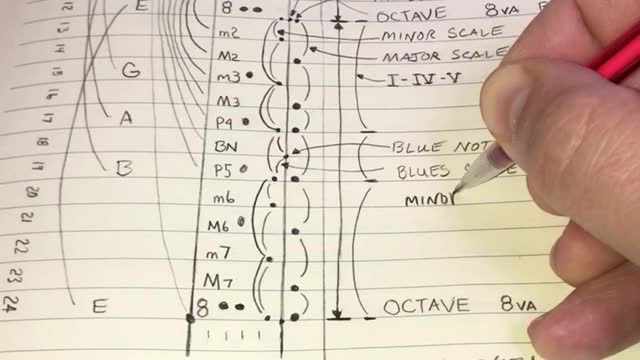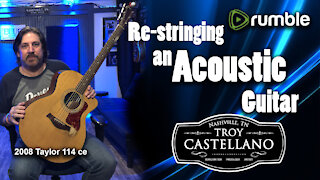Premium Only Content

Learn to count - Frets on a guitar fretboard - Beginning Guitar
In guitar, there are many ways of counting many different things.
In this video, we learn about scale length, root note, octave, half-steps, whole-steps,
Perfect 4th and Perfect 5th
All the minor and major scale degrees,
The blue note
Relative Minors and Relative Majors
“Learning to count” is a series of lessons that identify the various ways musicians “count” many different things...
When it comes fo the fretboard, the first thing we are taught is, this is the nut, and this is the bridge, and here is fret number 1, 2, 3, ...
So naturally we then begin to relate how we think about the fretboard in relation to how we are taught to count frets,
However, counting frets is just a temporary crutch, a bridge you use for a while, before you move on.
So, instead of showing a guitar student, ‘this is fret 1, this is hand position 1, heres some cowboy chords...’
We take it a step further, and have the student count the frets from 1 to 12,
Then talk about the two dots, how the 12th fret is the middle of the scale length,
And how every exercise is easier at the 12th fret, because thats the middle of the string, where its most flexible.
Do an exercise, for example, a bend, up a half step,
Do the bend string up half step at the 12th fret, then the 11, 10, 9 down to 1,
And note how much harder it is to bend a note on the 1st fret.
Then do bent note up half step exercise back up from fret 1, to fret 12,
And note the 12th fret feels easier than the 1st fret.
Then continue on to 13th etc frets, feeling how each bend at each fret feels slightly different.
Define scale length as the precisely measured length of guitar string from the nut to the bridge.
Get the student thinking in terms of the full string length, scale length, and fractions of the scale length
1/1 is open string length, the root note,
in this example its the E string
1/2 scale length is 8va also E
1/4 scale length is at 5th fret,
Which is located exactly below the perfect 4th harmonic node on the vibrating string.
1/3 scale length is the harmonic node point on the vibrating string, that is located directly above the 7th fret.
The 7th fret is 7 half steps above an open string root note.
7 half steps is the perfect 5th.
The 4 bass strings on an E standard tuned guitar are offset such that each set of adjacent strings is offset by a perfect 4th,
...
And how at a ‘lower’ fret number, you are using more of the scale length of the guitar string, and have a ‘lower’ sounding tone.
Do rote listening exercises.
[On an E standard tuned guitar EADGBE]
Root-octave (compare ‘is’ with ‘is not’).
Do listening discernment exercises, where you listen and compare the two E sounds, of the root and the octave, (open, 12th, open, 12th... )
During exercise, say out loud, annunciate, in a loud singing or chanting voice that could be clearly heard by an audience
(Low E, High E, Root, Octave, One, Eight, Zero, Twelve...)
And then do listening discernment exercise where you listen and compare
‘E’ and ‘NOT E’
Open string root note E, and 12th fret is E
Open E, 11th fret is ‘NOT E’
Open E, 13th fret is ‘NOT E’
And go back and forth, tick tock,
sounding the open E root note, as a reference tone that you are actively listening to, and telling yourself that the sound is E, and verifying the sound is E, with a tuner.
Go from the 12th fret, down to the 1st fret, and tick-tick, listen to E root open string, and the sound of each fretted note from 12 down to 1, listening, and saying ‘E, NOT E, E, NOT E... and verify by listening that each of the sounds made by the other 11 frets were ‘NOT E’.
For the purpose of this exercise, we only want to discern, by active listening, that a root note, and its octave, do sound the same, which is, ‘E’
And to discern, by active listening, that your root note is E, and all other notes/frets are ‘NOT E’
From 12 down to 1,
and back up from 1 to 12,
And beyond 12, to as many frets as your guitar has,
And then beyond the last fret...
‘is E, or is not E? ... that is the question!’
-
 5:15
5:15
Beginner Guitar
1 year agoProve My Hypotheses by Death Cab for Cutie
7881 -
 1:53
1:53
Chris Peters Guitar
4 years agoLearn Guitar Online!
87 -
 9:59
9:59
Bunker Guitars
3 years agoHow To Fix Worn Guitar Frets
1035 -
 17:37
17:37
Troy Castellano, Nashville Musician and Songwriter
4 years ago $0.01 earnedLearn To Restring An Acoustic Guitar
507 -
 9:18
9:18
YourGuitarSage
4 years agoLearn Guitar WAY Faster Than I Did
7825 -
 0:35
0:35
Beginner Guitar
3 years agoBeginning guitar - Right hand thumb plays all strings
421 -
 1:44
1:44
Flamenco4U
4 years ago $0.01 earnedFretboard Familiarity Zig-Zag Scale | Flamenco Guitar Tutorial | Guitarra Flamenca
65 -
 13:41
13:41
Chris Peters Guitar
4 years agoLearn The Dorian Mode For Guitar. Made Easy!
52 -
 8:00
8:00
Flamenco4U
4 years agoGetting Familiar w/ the Fretboard: Chromatic Scale | Flamenco Guitar Tutorial | Guitarra Flamenca
38 -
 9:26
9:26
YourGuitarSage
4 years agoHow To Easily Memorize All the Notes on the Guitar Fretboard
319